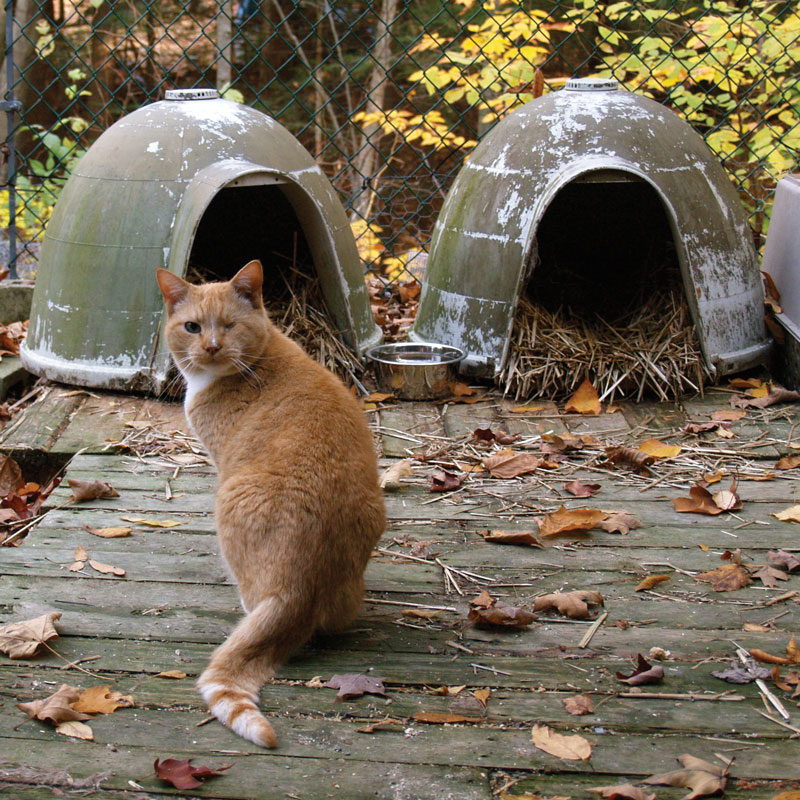
Kristen Hassen, Maddie’s® American Pets Alive! Director overseeing Human Animal Support Services (HASS)
October 5, 2021
Dr. Kelly Diehl, D.V.M., Senior Director of Science and Communication of Morris Animal Foundation, Small Animal Internal Medicine Specialist and Veterinary Journalist
October 12, 2021
Original article contributed by Liz Pease | Update by Brianna Lovell Myers
It’s that special time of year. The leaves are changing, the weather is turning, and pumpkin spice is in demand. As fall takes hold, I bet we’re all starting to think the same thing–time to winterize our feeding stations and shelter for our outdoor cats!
While Winter may not be here yet, when it comes to planning and preparing our outdoor cats, it’s always best to be ahead of the game. This way, you and your cats will be prepared for a sudden cold-snap or sudden storm.
Even if you live in an area of the country where the weather doesn’t get cold, it is still a good idea to do a deep clean-out of your feeding stations and shelters at least twice a year.
Are you building a winter shelter for the first time? Wonderful! There are lots of resources available to help. Neighborhood Cats is a great place to start if you are looking for more information on building or buying winter shelters.
Now, here’s a quick guide on preparing your outdoor spaces for cats.
Clean and Refresh Your Feeding Stations and Shelters
First up, you’ll want to clean out old debris and used straw from your feeding stations and shelters. You will need work gloves, trash bags, a rake and broom, a sturdy dustpan, straw*, a spray bottle with water, cloths, and duct tape (you never know when you might need it!).
Cleaning out your feeders and shelters is a great activity for a nice weekend in early Fall. I would recruit friends to help if you can. Many hands make light work — plus, some of the wet straw left over from last year can be heavy!
Step 1: Remove the old straw from the shelters and sweep the feeding areas clean with your dustpan and broom.
Step 2: Repair anything that needs fixing, especially if it may be a safety concern. Loose nails? Crumbling styrofoam? Make sure your feeding stations and shelters are safe and ready for the long winter ahead.
Step 3: Wipe down surfaces. While you will want to clean the inside of the shelters, avoid using any cleaners with a strong odor like bleach, or heavily perfumed products, etc. The cats might not like the smell. A light cleaning with a simple bottle of water is the best idea.
Step 4: Allow to dry!
Step 5: Restock your shelters with fresh, dry straw. Yes, straw–not hay! Straw is hollow and will keep cats warm and dry. Hay retains moisture and will quickly become a wet, moldy mess.
Step 6: Replace worn out bowls. If you use heavy bowls that stay at the location, replace them with new or freshly cleaned bowls.
Step 7: Clean up the site. Carefully bag and remove all the old straw and debris from your shelters, as well as any other trash in the area, even if it isn’t yours. This is a great opportunity to reinforce positive neighbor/community relations. Folks will appreciate you putting in the extra effort!
Hot Tips for the Cold Winter Months
These tried and true tips from the field will keep your cats feeling cozy all winter long.
Elevate your feeding stations. If at all possible, elevate your feeding stations to keep the high and dry from the winter weather. Here’s one example from Feral Villa. You can also make this a simple DIY by adding 4×4 beams to the bottom of your existing stations! There are a lot of great designs out there (as a quick Google search will prove), so you should have no trouble finding something that works for you, your site, and your budget.
Situate your feeding stations and shelters wisely. You’ll want to face them away from the prevailing winds in your area so the cold air, rain, and snow don’t blow in. Keep them away from areas that frequently flood or pool water. Check on your shelters periodically (especially after a heavy storm or rain) to see whether the straw is still dry.
Use heat sources to keep food and water from freezing. Place microwaveable heating discs (Google “Snuggle Safe” discs for an example) or disposable hand warmers, etc. underneath food and water bowls to keep them warmer longer.
NEVER USE BLANKETS. Even the warmest, fuzziest blanket will be a no-no for outdoor cats. It will inevitably get (and stay) wet. In time it will freeze, essentially turning a well-intentioned blanket into an unwelcome ice pack.
Other Colony Care Tips
If you rely on other volunteers to feed and care for the cats, this is an excellent time to reconnect and ensure they have everything they need. Provide them with new supplies, and ask about the general health of the colony. Are there any medical concerns? Newcomers? You might also talk about your backup plans for bad weather. Will they be able to feed when it snows? Who is going to shovel after a big storm? Make a plan, and make sure everyone has the correct contact information to stay in touch.
For even more ideas, check out our Colony Caretaking Tips & Tricks webinar, presented by Neighborhood Cats. This webinar is now available for free on our Community Cat Care Training & Education resource page and has tons of information to help you and your outdoor cats all year long.
Happy fall, and happy cleaning! Be sure to reach out and let us know how you shelter and feed your community cats!
Brianna Lovell Myers is an independent consultant who specializes in program support and project management for mission-driven organizations. She started her own business, Breezy Consulting, to aid and empower organizations serving and supporting animals. Her background includes management roles in outreach, programs, and events for Alley Cat Allies. Today, Brianna is a valued member of the Community Cats Podcast team, where she oversees the Community Cats Podcast Affiliate Program, Community Cats Grants Program, and more.




